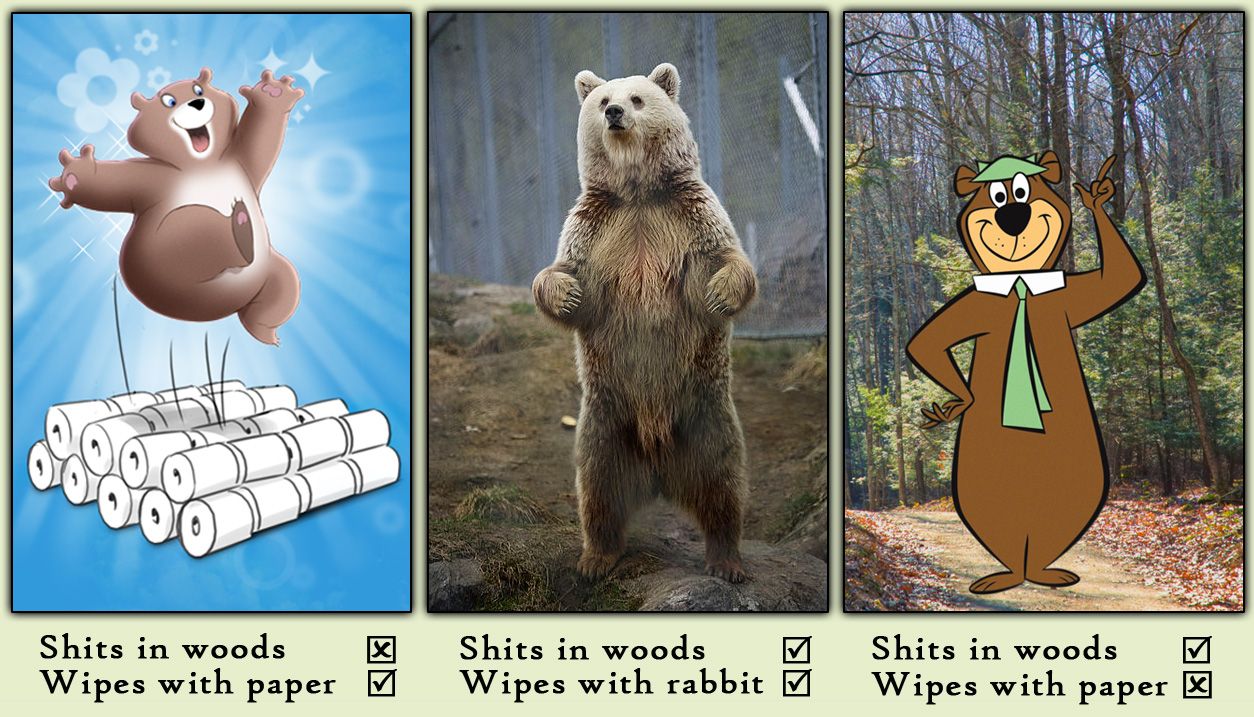Sometimes the bear eats you
And sometimes, when you poke the bear,
He gets all pissed off, too.
People who get their impressions of what bears are like from Popular Culture will, inevitably, receive a rude surprise if they happen upon the real thing.
Admit it. When you think of bears, what images come to mind? Yogi Bear, always matching wits with Ranger Smith in his quest for tourists’ pic-a-nic baskets? The Coca-Cola polar bears? The Charmin Toilet Paper Bears, with their seeming obsession with the act of defecation and the process of cleaning up thereafter? Smokey the Bear?

A posse of popular bears. [Click to embiggen.]
Don’t be fooled by those ridiculous media creations. A real bear would just as soon disembowel you and gnaw on your steaming innards as tell you to douse your campfire. No: That should read, “A real bear would be much more likely to disembowel you and gnaw on your steaming innards as tell you to douse your campfire.”
Much like humans, bears are dangerous despite their cuddly exterior. And like humans, they are omnivores, culinary switch hitters who can eat nuts and berries one minute, a freshly caught salmon the next, and then a screaming backpacker by way of dessert. Just ask Timothy Treadwell, who made the fatal mistake of thinking bears were nothing more than warm, lovable, hairy people.
Michael Pollan, in his book The Omnivore’s Dilemma, speculates that the development of human intelligence and language may have been driven by the evolutionary pressure of coping with our omnivorous diet. Monovores - think pandas with their bamboo, koalas with their eucalyptus leaves - don’t have to worry about whether a given dietary item might be harmful or toxic. They just eat the one thing they’re programmed to eat. Humans, on the other hand, can consume pretty much anything, flexibility that exposes us to a whole host of potentially dangerous foodstuffs. Which berries are deadly and which safe? Which mushrooms? And what about those white rocks that come out of a chicken’s ass - can we eat those? Can we eat the chicken, too? Thanks to our intelligence and command of language - the ability to transmit knowledge and culture - we are able to eat of the bounty of Nature and survive the experience.
One could speculate that bears, who also partake of the omnivorous diet, are also subject to the forces of natural selection, forces that, conceivably, could eventually create the spark of intelligence. Terry Bisson, in his short story “Bears Discover Fire,” presents that selfsame scenario, although he does not so much explain the causes as he does picture the results.
Whether bears ever manage to achieve sentience sufficient for them to manage combustion, one thing will still be certain: If you poke them with sticks, they will become somewhat peeved. And a peeved bear is something you do not want to deal with... even if he wears a tie and a porkpie hat.




















1 comment:
This post really delivers. The highs, the lows! Oh Treadwell, what a simpleton! Loved his documentary. Ever eat bear? (I have; very greasy.) Is it Kosher? (my gut instinct says no.) I'm a huge fan of Pollan's work. With very few exclusions, I do not eat corn any more; I eschew "organic" (unless it's for leafy salad greens--a rarity for me); and I try to eat in season and as local as possible. No good has ever come from eating a tomato or watermelon in the depths of January or February. Hot house or no.
Post a Comment